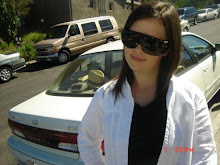
I saw
Twenties Girl
on the new fiction shelf at the library, grabbed it, and took it home without even reading the book jacket copy. Sophie Kinsella knows from chick lit, and I will give anything she writes a chance. Although her characters can be a little zany and and hijinks usually ensue (hello,
Shopolic series), her books are still well-constructed and just plain fun. I may roll my eyes a few times, but I like being along for the ride.
Lara Lington has always had an overactive imagination, but suddenly that imagination seems to be in overdrive. Normal professional twenty-something young women don't get visited by ghosts. Or do they? When the spirit of Lara's great-aunt Sadie -- a feisty, demanding girl with firm ideas about fashion, love, and the right way to dance -- mysteriously appears, she has one last request: Lara must find a missing necklace that had been in Sadie's possession for more than seventy-five years, and Sadie cannot rest without it. Lara, on the other hand, has a number of ongoing distractions. Her best friend and business partner has run off to Goa, her start-up company is floundering, and she's just been dumped by the "perfect" man. Sadie, however, could care less. Lara and Sadie make a hilarious sparring duo, and at first it seems as though they have nothing in common. But as the mission to find Sadie's necklace leads to intrigue and a new romance for Lara, these very different "twenties" girls learn some surprising truths along the way.
(That would be the book jacket copy that I finally read after getting home.)
Unsurprisingly, I really enjoyed this book. I read it in one sitting on a night when Colin had to work, and it was great company. I wasn't sure if I would enjoy the twenties theme, it's not an era that I'm especially interested in, but I really did. Kinsella's love for the subject shines through, and it was fun to read about this firmly twenties-era girl stuck in present day.
I liked that there was an actual mystery behind the disappearance of the necklace that Lara had to solve. I thought she would just be tracking it down and bantering with her ghost along the way, so I wasn't trying to keep track of clues and solve it for myself as I usually do when I read a mystery. When Lara figures out the who and the why and the how -- and how to give the culprit their comeuppance -- it's tremendously satisfying. Looking back, you had all the clues that you needed to piece it all together, but you don't feel silly for not knowing the end three hundred pages ago.
The book also had a bit more heft to it than I was expecting. Lara's story begins on the day of Sadie's funeral. Her great-aunt was 105 years old when she passed away, and no one in the family really knew anything about her. It was simple familial obligation that even got Lara and her parents to the funeral home. Sadie's ghost appears to Lara as her 23-year-old self, because that's who she always saw in the mirror. Lara realizes that most elderly people must feel the same way; instead of thinking of themselves as old, they probably still see themselves as young. When she visits Sadie's nursing home to collect her belongings, Lara sees the residents as forgotten. Over the course of the story, Lara and Sadie become good friends, and Lara feels ashamed that she knew next to nothing about her when she died. Lara makes Sadie tell her everything about her life, not wanting anything about Sadie to be forgotten. The message came through loud and clear, but I didn't feel beaten over the head with it.
One aspect of the story that I really enjoyed was the fact that Lara's Uncle Bill started a Starbucks-esque chain of coffee shops. Being a coffee aficionado, I thought it was a really cool choice for his business. Bill is a multi-millionaire, with a wife who ends up in rehab and a spoiled daughter who aspires to be a fashion designer. It was a great send-up of celebrity, and the fact that coffee made Bill rich -- I really liked it.
Of course, there was some zaniness and a few hijinks. Sadie appears to Lara during the funeral and demands that she find the necklace before they bury Sadie's body. So Lara accuses the nursing home employees of murdering her aunt to delay the burial. (Commence eye-rolling.) It works, and she is questioned by the police a few times throughout the story. It doesn't take too much away from the book, but it wasn't entirely necessary either. All in all, I still whole-heartedly recommend this book. It's thoroughly enjoyable, chick lit at its best.











